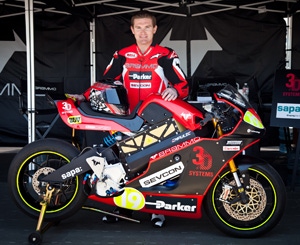August 26, 2010

Anew all-electric motorcycle built by Brammo Inc. is using a MPP series tractionmotor and innovative cooling technology to maximize power density and peaktorque output. The motor technology yields up to 40 percent higher torque perunit size than conventionally constructed permanent magnet motors, and delivers20 to 350kW of power with 97 percent efficiency.
The Brammo bike was unveiled at the Red BullUS Grand Prix at the Mazda Raceway in Laguna Seca, CA, where a major race tookplace as part of the FIM e-power race series.
What the MPP traction motortechnology embodies is a high-efficiency solution that offers broad scalabilityand manufacturability. But from a performance and technology standpoint, what createsthe high motor power density that fits well into electric vehicles is innovativecooling technology that maximizes motor performance.
"We've added a dual cooling system to ourmotors that features patent-pending dry-rotor internal cooling technology,"says Jay Schultz, a product manager for Parker's Electromechanical AutomationDiv. "As we implement these on our motors, it increases the peak power outputup to four times."
Schultz says that, for example, if a standardmotor has a power output of 20 kW peak, the equivalent MPP traction motor willoutput 80 kW peak, with very little added weight. The difference is largely attributeddirectly to superior cooling of the motor which significantly increases powerdensity.
Internal cooling also raises the continuouspower of the motor by 8.5 times because as the race bike is acceleratingoutside of every curve, maintaining continuous power as high as possible isextremely important in the dynamics of how the bike operates.
"If you think about what causes torque, it isthe current inside of the motor windings. When you are running current throughthe windings, there are losses but our internal cooling extracts losses in theform of heat by taking them directly from the windings back out to ambient,"says Schultz.
In atypical application, losses go from the winding, to a lamination, the case andfinally to ambient. But with this technology, losses in the form of heat move directlyfrom the windings to ambient which improves continuous power outputsubstantially.
Target electrification applications for theMPP technology include jet skis, forklifts, compact cars, sedans, vans, lightduty trucks, high-performance sports cars, medium duty trucks, large boats,buses and Class 8 trucks. Across all of these applications, the internal andexternal cooling technology has been employed, but dual cooling is particularlyuseful where there is aggressive power usage such as marine applications, Class8 trucks and this electric race bike.
"With other vehicles such as asports car where you are running primarily at very high speeds, the applicationis not continuously requiring high continuous power from the motor," saysSchultz. "With this application, we took the power density of the motor to themax and squeezed it into the tightest possible package."
When the bike makes its debut in September, Brammois hoping that the leaders in the racing circuit will have a serious newcontender vying to capture the winning trophy. Brammo also plans to market astreet version of the race bike for the commercial market next year. Brammo andParker are working through the details around a smaller MPP motor for theproduction version.
Click hereto read the Parker Electromechanical Automation blog.
About the Author(s)
You May Also Like





